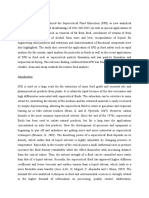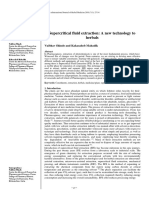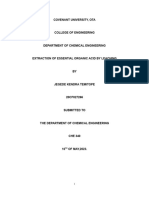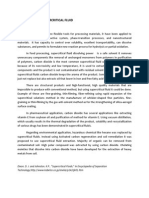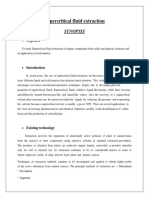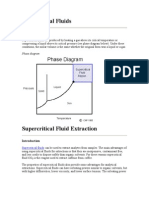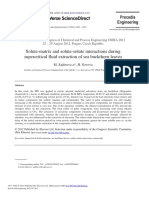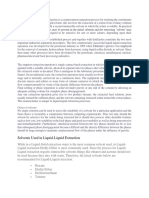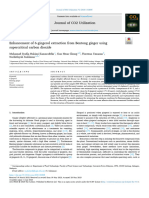Supercritical Fluid Extraction: - A Review
Supercritical Fluid Extraction: - A Review
Uploaded by
nadpharm13Copyright:
Available Formats
Supercritical Fluid Extraction: - A Review
Supercritical Fluid Extraction: - A Review
Uploaded by
nadpharm13Original Description:
Original Title
Copyright
Available Formats
Share this document
Did you find this document useful?
Is this content inappropriate?
Copyright:
Available Formats
Supercritical Fluid Extraction: - A Review
Supercritical Fluid Extraction: - A Review
Uploaded by
nadpharm13Copyright:
Available Formats
Int. J. Chem. Sci.
: 8(2), 2010, 729-743
- A REVIEW
SUPERCRITICAL FLUID EXTRACTION
G. N. SAPKALE*, S. M. PATIL, U. S. SURWASE and P. K. BHATBHAGE
Department of Pharmacognosy, ASPM,S K. T. Patil College of Pharmacy, Siddharth Nagar,
Barshi Road, OSMANABAD 413501 (M.S.) INDIA
ABSTRACT
Supercritical fluid extraction is the most effective and efficient way to extract valuable
constituent botanicals. Supercritical Fluid Extraction (SFE) is the process of separating one component
(the extractant) from another (the matrix) using supercritical fluids that is CO2 as the extracting solvent.
CO2 is the king of extraction solvents for botanicals. Extraction conditions for supercritical CO2 are above
the critical temperature of 31C and critical pressure of 74 bar. Supercritical fluids are highly compressed
gases, which have combined properties of gases and liquids in an intriguing manner. Supercritical fluids
can lead to reactions, which are difficult or even impossible to achieve in conventional solvents. It is a fast
process completed in 10 to 60 minutes. A supercritical fluid can be separated from analyte by simply
releasing pressure, leaving almost no trace and yields a pure residue.
Key words: Supercritical fluid extraction, Applications.
INTRODUCTION
Extraction can be defined as the removal of soluble material from an insoluble
residue, either liquid or solid, by treatment with a liquid solvent. It is therefore, a solution
process and depends on the mass transfer phenomena. The controlling factor in the rate of
extraction is normally the rate of diffusion of the solute through the liquid boundary layer at
the interface.
Extraction involves the separation of medicinally active portions of plant or animal
tissue from the inactive or inert components using selective solvents in standard extraction
procedures. The products so obtained from plants are relatively impure liquids, semisolids or
powders intended only for oral or external use. So extraction continues to be of considerable
interest in order to obtain improved yields of drug derived from plant and animal sources.
________________________________________
*
Author for correspondence; E-mail: geeta_sapkale@rediffmail.com, shivapatilg@rediffmail.com,
ulhas_pharma@rediffmail.com, bpranita@ymail.com
730
G. N. Sapkale et al.: Supercritical Fluid.
Techniques of extraction methods continue to be investigated and applied to obtain higher
yields of the active substances from natural sources. The principle methods of extraction are Maceration
Percolation
Digestion
Infusion
Decoction
Solvent extraction
Solvent extraction also known as liquid-liquid extraction and partitioning, is a
method to separate compounds based on their relative solubilities in two different
immiscible liquids, usually water and an organic solvent. It is an extraction of a substance
from one liquid phase into another liquid phase. It is a basic technique in chemical
laboratories, where it is performed using a separatory funnel. In other words, this is the
separation of a substance from a mixture by preferentially dissolving that substance in a
suitable solvent. Solvent extraction may be made use analytically for concentrating or
rejecting a particular substance, or for the separation of mixtures. This process usually
separates a soluble compound from an insoluble compound. Solvent extraction is used in
nuclear processing, ore processing, production of fine organic compounds, processing of
perfumes and other industries. Thus, although the method can be used for extraction and
preconcentration of a wide range of non volatile or semi volatile species from water using
only routine laboratory equipments, its use is decreasing in most situations because solvents
of the required purity tend to be expensive, and can also cause problems with proper
disposal after use.
Supercritical fluid extraction
Often the analysis of complex materials requires, as a preliminary step that is,
separation of the analyte or analytes from a sample matrix. Ideally, an analytical separation
method should be rapid, simple and inexpensive; should give quantitative recovery of
analytes without loss or degradation; should yield a solution of the analyte that is sufficiently
concentrated to permit the final measurement to be made without the need for concentration;
should generate little or no laboratory wastes that have to be disposed off.
For many years, one of the most common methods for performing analytical
Int. J. Chem. Sci.: 8(2), 2010
731
separations on complex environmental, pharmaceutical, food and petroleum samples was
based upon extraction of bulk samples with hydrocarbon or chlorinated organic solvents
using a Soxhlet extractor. Unfortunately, liquid extraction frequently fails to meet several of
the ideal criteria. They usually require several hours or more to achieve satisfactory
recoveries of analytes and even sometimes fails to do. The solvent costs are often high. The
solutions of the recovered analytes are often so dilute so that a concentration step must
follow the extraction. Analyte degradation or loss as well as atmospheric pollution may
accompany this concentration step.
Beginning in the mid-1980, chemists began to explore the use of supercritical fluids
for the separation of analytes from the matrix of many samples of interest to industry and
governmental agencies because use of reagents of this type avoids many of the problems for
organic liquid extractants.
What is Supercritical Fluid Extraction ?
Supercritical fluids have been investigated since last century, with the strongest
commercial interest initially focusing on the use of supercritical toluene in petroleum and
shale oil refining during the 1970s. Supercritical water is also being investigated as a means
of destroying toxic wastes, and as an unusual synthesis medium. The biggest interest for the
last decade has been the applications of supercritical carbon dioxide, because it has a nearambient critical temperature (310C), thus biological materials can be processed at
temperatures around 350C. The density of the supercritical CO2 at around 200 bar pressure is
close to that of hexane, and the solvation characteristics are also similar to hexane; thus, it
acts as a non-polar solvent. Around the supercritical region, CO2 can dissolve triglycerides at
concentrations up to 1% mass. The major advantage is that a small reduction in temperature,
or a slightly larger reduction in pressure, will result in almost the entire solute precipitating
out as the supercritical conditions are changed or made sub critical. Supercritical fluids can
produce a product with no solvent residues. Examples of pilot and production scale products
include decaffeinated coffee, cholesterol-free butter, low-fat meat, evening primrose oil,
squalene from shark liver oil, etc. The solvation characteristics of supercritical CO2 can be
modified by the addition of an entrainer, such as ethanol, however some entrainer remains as
a solvent residue in the product, negating some of the advantages of the "residue-free
extraction.
Supercritical fluid extraction (SFE) is the process of separating one component (the
extractant) from another (the matrix) using supercritical fluids as the extracting solvent.
Extraction is usually from a solid matrix, but it can also be from liquids. SFE can be used as
732
G. N. Sapkale et al.: Supercritical Fluid.
a sample preparation step for analytical purposes, or on a larger scale to either strip
unwanted material from a product (e.g. decaffeination) or collect a desired product (e.g.
essential oils). Carbon dioxide (CO2) is the most used supercritical fluid, sometimes
modified by co-solvents such as ethanol or methanol. Extraction conditions for supercritical
CO2 are above the critical temperature of 31C and critical pressure of 74 bar. Addition of
modifiers may slightly alter this. Supercritical extraction mostly uses carbon dioxide at high
pressure to extract the high value products from natural materials. Unlike other processes,
the extraction process leaves no solvent residue behind. Moreover the CO2 is non-toxic, nonflammable, odorless, tasteless, inert, and inexpensive. Due to its low critical temperature
31C, carbon dioxide is known to be perfectly adapted in food, aromas, essential oils and
nutraceutical industries.
Supercritical fluid
A supercritical fluid is any substance at a temperature and pressure above its critical
point. It can diffuse through solids like a gas, and dissolve materials like a liquid.
Additionally, close to the critical point, small changes in pressure or temperature result in
large changes in density, allowing many properties of a supercritical fluid to be "fine-tuned".
Supercritical fluids are suitable as a substitute for organic solvents in a range of industrial
and laboratory processes. Carbon dioxide and water are the most commonly used
supercritical fluids, being used for decaffeination and power generation, respectively. CO2 is
the kind of extraction solvents for botanicals. It leaves no toxic residue behind. Its extraction
properties can be widely and precisely manipulated with subtle changes in pressure and
temperature.
There are 2 types of CO2 extraction -
Low pressure cold extraction
Ii involves chilling CO2 at 35-550F and pumping it through the plant material at
between 800-1500 psi.
Supercritical extraction
It involves heating the CO2 to above 870F and pumping it above 1100 psi. Usually,
this is between 6000-10000 psi. Supercritical fluid CO2 can best be described as a dense fog
when CO2 is used in a dense liquid state. Low-pressure CO2 is often the best method for
producing high quality botanical extracts. CO2 loading rate in this state means that you have
to pump many volumes of CO2 through botanical. The loading rate is typically 10-40
Int. J. Chem. Sci.: 8(2), 2010
733
volumes. For this reason, it is important to have pumped CO2, which has a much faster
loading rate 2-10 volumes and a wide range of uses.
Properties of supercritical fluid
(i)
Supercritical fluids have highly compressed gases, which combine properties
of gases and liquids in an intriguing manner.
(ii)
Supercritical fluids can lead to reactions, which are difficult or even
impossible to achieve in conventional solvents.
(iii) Supercritical fluids have solvent power similar to light hydrocarbons for most
of the solutes. However, fluorinated compounds are often more soluble in
supercritical CO2 than in hydrocarbons; this increased solubility is important
for polymerization.
(iv) Solubility increases with increasing density (that is with increasing pressure).
Rapid expansion of supercritical solutions leads to precipitation of a finely
divided solid. This is a key feature of flow reactors.
(v)
The fluids are commonly miscible with permanent gases (e.g. N2 or H2) and
this leads to much higher concentrations of dissolved gases than can be
achieved in conventional solvents.
In general terms, supercritical fluids have properties between those of a gas and a
liquid.
Table 1: Critical properties for some components commonly used as supercritical
fluids
Critical properties of various solvents (Reid et al., 1987)
Solvent
Molecular
weight
(g/mol)
Critical
temperature
(K)
Critical
pressure
MPa (atm)
Critical
density
(g/cm3)
Carbon dioxide (CO2)
44.01
304.1
7.38 (72.8)
0.469
Water (H2O) (acc. IAPWS)
18.015
647.096
22.064 (217.755)
0.322
Methane (CH4)
16.04
190.4
4.60 (45.4)
0.162
Cont
734
G. N. Sapkale et al.: Supercritical Fluid.
Solvent
Molecular
weight
(g/mol)
Critical
temperature
(K)
Critical
pressure
MPa (atm)
Critical
density
(g/cm3)
Ethane (C2H6)
30.07
305.3
4.87 (48.1)
0.203
Propane (C3H8)
44.09
369.8
4.25 (41.9)
0.217
Ethylene (C2H4)
28.05
282.4
5.04 (49.7)
0.215
Propylene (C3H6)
42.08
364.9
4.60 (45.4)
0.232
Methanol (CH3OH)
32.04
512.6
8.09 (79.8)
0.272
Ethanol (C2H5OH)
46.07
513.9
6.14 (60.6)
0.276
Acetone (C3H6O)
58.08
508.1
4.70 (46.4)
0.278
Table 2: Density, diffusivity and viscosity for typical liquids, gases and supercritical
fluids
Comparison of gases, supercritical fluids and liquids
Density (kg/m3)
Viscosity (Pas)
Diffusivity (mm/s)
Gases
10
1-10
Supercritical fluids
100-1000
50-100
0.01-0.1
Liquids
1000
500-1000
0.001
All supercritical fluids are completely miscible with each other so for a mixture, a
single phase can be guaranteed, if the critical point of the mixture is exceeded. The critical
point of a binary mixture can be estimated as the arithmetic mean of the critical temperatures
and pressures of the two components,
Tc (mix) = (Mole fraction A) x TcA + (Mole fraction B) x TcB.
(1)
For greater accuracy, the critical point can be calculated using equations of state,
such as the Peng Robinson, or group contribution methods. Other properties, such as density,
can also be calculated using equations of state.
Int. J. Chem. Sci.: 8(2), 2010
735
Phase diagram
10000
solid
Supercritical
fluid
Pressure (bar)
1000
liquid
100
10
gas
200
250
300
350
400
Temperature (K)
Density (kg/m3)
Fig. 1: Carbon dioxide pressure-temperature phase diagram
1000
280 K
800
300 K
310 K
330 K
600
400
400 K
200
0
30
50
70 90 110 130 150 170
Pressure (bar)
Fig. 2: Carbon dioxide density-pressure phase diagram
Figs. 1 and 2 show projections of phase diagrams. In the pressure-temperature phase
diagram (Fig. 1), the boiling separates the gas and liquid region and ends in the critical point,
where the liquid and gas phases disappear to become a single supercritical phase.
This can be observed in the density-pressure phase diagram for carbon dioxide, as
shown in Fig. 2. At well below the critical temperature, e.g. 280 K, as the pressure increases,
the gas compresses and eventually (at just over 40 bar) condenses into a much denser liquid,
736
G. N. Sapkale et al.: Supercritical Fluid.
resulting in the discontinuity in the line (vertical dotted line). The system consists of 2
phases in equilibrium, a dense liquid and a low-density gas. As the critical temperature is
approached (300 K), the density of the gas at equilibrium becomes denser, and that of the
liquid lower. At the critical point, (304.1 K and 7.38 MPa (73.8 bar)), there is no difference
in density, and the 2 phases become one fluid phase. Thus, above the critical temperature, a
gas cannot be liquefied by pressure. At slightly above the critical temperature (310 K), in the
vicinity of the critical pressure, the line is almost vertical. A small increase in pressure
causes a large increase in the density of the supercritical phase. Many other physical
properties also show large gradients with pressure near the critical point, e.g. viscosity, the
relative permittivity and the solvent strength, which are all closely related to the density. At
higher temperatures, the fluid starts to behave like a gas, as can be seen in Fig. 2. For carbon
dioxide at 400 K, the density increases almost linearly with pressure.
Many pressurized gases are actually supercritical fluids. For example, nitrogen has a
critical point of 126.2 K (-147C) and 3.4 MPa (34 bar). Therefore, nitrogen in a gas
cylinder above this pressure (or compressed air) is actually a supercritical fluid. These are
more often known as permanent gases. At room temperature, they are well above their
critical temperature, and therefore, behave as a gas, similar to CO2 at 400 K above. However,
they cannot be liquefied by pressure unless cooled below their critical temperature.
Supercritical fluid extraction process
The system must contain a pump for the CO2, a pressure cell to contain the sample, a
means of maintaining pressure in the system and a collecting vessel. The liquid is pumped to
a heating zone, where it is heated to supercritical conditions. It then passes into the
extraction vessel, where it rapidly diffuses into the solid matrix and dissolves the material to
be extracted. The dissolved material is swept from the extraction cell into a separator at
lower pressure, and the extracted material settles out. The CO2 can then be cooled, recompressed and recycled, or discharged to atmosphere.
Pumps
Carbon dioxide is usually pumped as a liquid, usually below 5C and a pressure of
about 50 bars. The solvent is pumped as a liquid as it is then almost incompressible. As a
supercritical fluid, much of the pump stroke will be "used up" in compressing the fluid,
rather than pumping it. For small-scale extractions (up to a few grams/minute), reciprocating
CO2 pumps or syringe pumps are often used. For larger scale extractions, diaphragm pumps
are most common. The pump heads will usually require cooling, and the CO2 will also be
cooled before entering the pump.
Int. J. Chem. Sci.: 8(2), 2010
737
Pressure vessels
Pressure vessels can range from simple tubing to more sophisticated purpose built
vessels with quick release fittings. The pressure requirement is at least 74 bars, and most
extractions are conducted at less than 350 bar. However, sometimes, higher pressures will be
needed, such as extraction of vegetable oils, where pressures of 800 bars are sometimes
required for complete miscibility of the two phases.
The vessel must be equipped with a means of heating. It can be placed inside an
oven for small vessels, or oil or electrically heated jacket for larger vessels. Care must be
taken if rubber seals are used on the vessel, as the CO2 may dissolve in the rubber, causing
swelling, and the rubber will rupture on depressurization.
Pressure maintenance
The pressure in the system must be maintained from the pump right through the
pressure vessel. In smaller systems (up to about 10 mL/min), a simple restrictor can be used.
This can be either a capillary tube cut to length, or a needle valve, which can be adjusted to
maintain pressure at different flow rates. In larger systems a backpressure regulator will be
used, which maintains pressure upstream of the regulator by means of a spring, compressed
air, or electronically driven valve. Whichever is used, heating must be supplied, as the
adiabatic expansion of the CO2 results in significant cooling. This is problematic, if water or
other extracted material is present in the sample, as this may freeze in the restrictor or valve
and cause blockages.
Collection
The supercritical solvent is passed into a vessel at lower pressure than the extraction
vessel. The density, and thus, dissolving power, of supercritical fluids varies sharply with
pressure, and hence, the solubility in the lower density CO2 is much lower, and the material
precipitates for collection. It is possible to fractionate the dissolved material using a series of
vessels at reducing pressure. The CO2 can be recycled or depressurized to atmospheric
pressure and vented. For analytical SFE, the pressure is usually dropped to atmospheric, and
now the gaseous carbon dioxide is bubbled through the solvent to trap the precipitated
components.
Heating and cooling
This is an important aspect. The fluid is cooled before pumping to maintain liquid
conditions, and then heated after pressurization. As the fluid is expanded into the separator,
738
G. N. Sapkale et al.: Supercritical Fluid.
heat must be provided to prevent excessive cooling. For small-scale extractions, such as for
analytical purposes, it is usually sufficient to pre-heat the fluid in a length of tubing inside
the oven containing the extraction cell. The restrictor can be electrically heated, or even
heated with a hair dryer. For larger systems, the energy required during each stage of the
process can be calculated using the thermodynamic properties of the supercritical fluid.
Concentration
Fig. 3: Schematic diagram of SFE apparatus
Distance accross sphere
Fig. 4: Concentration profiles during a typical SFE extraction
There are two essential steps to SFE, transport (by diffusion or otherwise) from with
the solid particles to the surface, and dissolution in the supercritical fluid. Other factors, such
as diffusion into the particle by the SF and reversible release such as desorption from an
Int. J. Chem. Sci.: 8(2), 2010
739
Concentration
active site are sometimes significant, but not dealt in detail here. Fig. 4 shows the stages
during extraction from a spherical particle where at the start of the extraction, the level of
extractant is equal across the whole sphere Fig. 4(a). As extraction commences, material is
initially extracted from the edge of the sphere, and the concentration in the center is
unchanged Fig 4(b). As the extraction progresses, the concentration in the center of the
sphere drops as the extractant diffuses towards the edge of the sphere Fig. 4(c).
Distance accross sphere
Fig. 5: Concentration profiles for (a) diffusion limited and
(b) solubility limited extraction
The relative rates of diffusion and dissolution are illustrated by two extreme cases in
Fig. 5. Fig. 5(a) shows a case where dissolution is fast relative to diffusion. The material is
carried away from the edge faster than it can diffuse from the center, so the concentration at
the edge drops to zero. The material is carried away as fast as it arrives at the surface, and
the extraction is completely diffusion limited. Here, the rate of extraction can be increased
by increasing diffusion rate, for example raising the temperature, but not by increasing the
flow rate of the solvent. Fig. 5(b) shows a case where solubility is low relative to diffusion.
The extractant is able to diffuse to the edge faster than the solvent can carry it away, and the
concentration profile is flat. In this case, the extraction rate can be increased by increasing
the rate of dissolution, for example by increasing flow rate of the solvent.
The extraction curve of % recovery against time can be used to elucidate the type of
extraction occurring. Fig. 6(a) shows a typical diffusion controlled curve. The extraction is
initially rapid, until the concentration at the surface drops to zero, and the rate then becomes
much slower. The % extracted eventually approaches 100%. Fig. 6(b) shows a curve for
solubility limited extraction. The extraction rate is almost constant, and only flattens off
towards the end of the extraction. Fig. 6(c) shows a curve where there are significant matrix
effects, where there is some sort of reversible interaction with the matrix, such as desorption
740
G. N. Sapkale et al.: Supercritical Fluid.
from an active site. The recovery flattens off, and if the 100% value is not known, then it is
hard to tell that extraction is less than complete.
% Recovery
100%
Time
Fig. 6: Extraction profile for different types of extraction
Optimization
The optimum will depend on the purpose of the extraction. For an analytical
extraction is to determine, say, antioxidant content of a polymer, then the essential factors
are complete extraction in the shortest time. However, for production of an essential oil
extract from a plant, then quantity of CO2 used will be a significant cost, and "complete"
extraction is not required; a yield of 70 - 80% perhaps being sufficient to provide economic
returns. In another case, the selectivity may be more important, and a reduced rate of
extraction will be preferable if it provides greater discrimination. Therefore, few comments
can be made, which are universally applicable. However, some general principles are
outlined below.
Maximizing diffusion
This can be achieved by increasing the temperature, swelling the matrix, or reducing
the particle size. Matrix swelling can sometimes be increased by increasing the pressure of
the solvent, and by adding modifiers to the solvent. Some polymers and elastomers in
particular are swelled dramatically by CO2, with diffusion being increased by several orders
of magnitude in some cases.
Maximizing solubility
Generally, higher pressure will increase solubility. The effect of temperature is less
certain, as close to the critical point, increase in the temperature causes a decrease in density,
Int. J. Chem. Sci.: 8(2), 2010
741
and hence, dissolving power. At pressures well above the critical pressure, solubility is
likely to increase with temperature. Addition of low levels of modifiers (sometimes called
entrainers), such as methanol and ethanol, can also significantly increase solubility,
particularly of more polar compounds.
Optimizing flow rate
The flow rate of CO2 should be measured in terms of mass flow rather than by
volume because the density of the CO2 changes according to the temperature both; before
entering the pump heads and during compression. Coriolis flow meters are best used to
achieve such flow confirmation. To maximize the rate of extraction, the flow rate should be
high enough for the extraction to be completely diffusion limited (but this will be very
wasteful of solvent). However, to minimize the amount of solvent used, the extraction
should be completely solubility limited (which will take a very long time). Flow rate must
therefore be determined depending on the competing factors of time and solvent costs, and
also capital costs of pumps, heaters and heat exchangers. The optimum flow rate will
probably be somewhere in the region where both solubility and diffusion are significant
factors.
Advantages
Environmental improvement and reduced product contamination
SFE is an alternative to liquid extraction using solvents such as hexane or
dichloromethane. There will always be some residual solvent left in the extract and matrix,
and there is always some level of environmental contamination from their use. In contrast,
carbon dioxide is easy to remove simply by reducing the pressure, leaving almost no trace,
and it is also environmentally benign. The use of SFE with CO2 is approved by the Soil
Association for organic products. The CO2 used is largely a by-product of industrial
processes or brewing, and its use in SFE does not cause any extra emissions.
Selectivity
The solvent strength of a supercritical fluid can be varied by change in the pressure
and a lesser extent in the temperature.
For example, volatile oils can be extracted from a plant with low pressures (100 bar),
whereas liquid extraction would also remove lipids. Lipids can be removed using pure CO2
at higher pressures, and then phospholipids can be removed by adding ethanol to the solvent.
742
G. N. Sapkale et al.: Supercritical Fluid.
Speed
It is a fast process and completed in 10 to 60 minutes. It is a diffusion-based process,
with the solvent required to diffuse into the matrix, and the extracted material to diffuse out
of the matrix into the solvent. Diffusivities are much faster in supercritical fluids than in
liquids, and therefore extraction can occur faster. Also, there is no surface tension and
viscosities are much lower than in liquids, so the solvent can penetrate into small pores
within the matrix inaccessible to liquids.
Purity
A supercritical fluid can be separated from analyte by simply releasing pressure.
Supercritical fluids are cheap, inert and nontoxic. Thus, they are readily disposed off
after an extraction is completed by allowing them to evaporate into the atmosphere.
Recovery
Recovery of analytes becomes simple.
REFERENCES
1.
Gennaro, A. R. Remington. The Science and Practice of Pharmacy 20th Ed. Vol. 2nd p.
750
2.
S. J. Carter, Cooper and Gunns Tutorial Pharmacy, p. 1477
3.
B. K. Sharma Instrumental Methods of Chemical Analysis. P.C-21 to C-40.
4.
D. A. Skoog, F. J. Holler and, Crouch R. Stanley, Instrumental Analysis. Indian Ed.,
pp. 936-945
5.
Edit Szkely, Supercritical Fluid Extraction, Budapest University of Technology and
Economics. http://sunny.vemt.bme.hu/sfe/angol/supercritical.html. Retrieved 2007-1120.
6.
Supercritical Fluid Extraction, Density Considerations, http://eng.ege.edu.tr/ ~otles/
SupercriticalFluidsScienceAndTechnology/ Wc488d76f2c655.htm. Retrieved 200711-20.
7.
A. A. Clifford (2007-12-04), Calculation of Thermodynamic Properties of CO2 using
Peng Robinson equation of state, Critical Processes Ltd. http://www.critical
processes.com/ Calculation % 20 of % 20 density, % 20 enthalpy % 20 and % 20
entropy % 20 of % 20 carbon % 20 dioxide.htm
Int. J. Chem. Sci.: 8(2), 2010
743
8.
Y. Tanaka and O. Takeshi, Extraction of Phospholipids from Salmon Roe with
Supercritical Carbon Dioxide and an Entrainer. J. Oleo Sci., Japan Oil Chemists
Society,. 53(9): 417424 (2004).
9.
Tsung Min Kuo and Harold Gardner (Eds.) Lipid Biotechnology, Marcel Dekker Inc.
New York (2002) pp. 663-687.
10.
Calculation of Density, Enthalpy and Entropy for Supercritical Carbon Dioxide with
Examples, http://www.criticalprocesses.com/ Calculation % 20 of % 20 density, % 20
enthalpy % 20 and % 20 entropy % 20o f % 20 carbon % 20dioxide.htm. Retrieved,
12-17 (2007).
11.
Clifford, Tony, Fundamentals of Supercritical Fluids, Oxford Science Publications,
Oxford (1999).
12.
H. J. Vandenberg et al., Analytical Extraction of Additives from Polymers, Analyst
122: 101R115R, doi: 10.1039/ a704052k, http://www.rsc.org/ Publishing/ Journals/
AN/article.asp?doi=a704052k (1997)
13.
Supercritical Fluid Extraction, Density Considerations, http://eng.ege.edu.tr/~otles/
Supercritical Fluids Science and Technology/ Wc488d76f2c655.htm. Retrieved, 01-04
(2008).
Accepted : 20.02.2010
You might also like
- Extraction Techniques Medicinal PlantsDocument10 pagesExtraction Techniques Medicinal PlantsPramod Aryal100% (1)
- How Industrial Businesses Can Reduce Production Costs With Reverse Osmosis: Industrial Reverse OsmosisFrom EverandHow Industrial Businesses Can Reduce Production Costs With Reverse Osmosis: Industrial Reverse OsmosisRating: 5 out of 5 stars5/5 (1)
- Biogas Plant: Biogas Digester Design, Gas Production and PurificationFrom EverandBiogas Plant: Biogas Digester Design, Gas Production and PurificationRating: 3 out of 5 stars3/5 (1)
- Supercritical Fluid ExtractionDocument24 pagesSupercritical Fluid ExtractionMAHIMA BAIDNo ratings yet
- Supercritical FluidDocument5 pagesSupercritical FluidNuradila Athirah LockmanNo ratings yet
- Supercritical Carbon DioxideDocument3 pagesSupercritical Carbon DioxideRawda SeragNo ratings yet
- Methods of ExtractionDocument39 pagesMethods of ExtractionVijetha PendyalaNo ratings yet
- Organic Chemistry: Basra University College of Science and Technology Pharmacy DepartmentDocument10 pagesOrganic Chemistry: Basra University College of Science and Technology Pharmacy DepartmentcrtgyhujikNo ratings yet
- DSP Step 3, 4,, 5 2022Document26 pagesDSP Step 3, 4,, 5 2022AshwiniNo ratings yet
- Deep FreezerDocument15 pagesDeep FreezerAbhishek MahajanNo ratings yet
- good-MUCLecture 2022 123148640Document16 pagesgood-MUCLecture 2022 123148640baburao01803No ratings yet
- Word MtoDocument7 pagesWord MtoAvani TaiwadeNo ratings yet
- INTRODUCTIONDocument3 pagesINTRODUCTIONMxokzah CmohNo ratings yet
- Supercritical Extraction of Cannabi'S Oil Using CoDocument2 pagesSupercritical Extraction of Cannabi'S Oil Using CoMaria Valentina LopezNo ratings yet
- Chemical Engineering 20-12-19Document8 pagesChemical Engineering 20-12-19levineNo ratings yet
- Supercritical Fluid Extraction: A New Technology To Herbals: Vaibhav Shinde and Kakasaheb MahadikDocument8 pagesSupercritical Fluid Extraction: A New Technology To Herbals: Vaibhav Shinde and Kakasaheb Mahadikanwar hasanNo ratings yet
- Critical Review of Supercritical Fluid ExtractionDocument24 pagesCritical Review of Supercritical Fluid ExtractionQuynhNo ratings yet
- Sfe PDFDocument9 pagesSfe PDFKeshav RajputNo ratings yet
- SCF Applications in Pharmaceutical IndustryDocument32 pagesSCF Applications in Pharmaceutical IndustryYOYO_riskNo ratings yet
- Comparison of Different Extraction Methods For The Extraction of Major Bioactive Flavonoid Compounds From Spearmint Mentha Spicata L. LeavesDocument6 pagesComparison of Different Extraction Methods For The Extraction of Major Bioactive Flavonoid Compounds From Spearmint Mentha Spicata L. LeavesDinar AmaliaNo ratings yet
- Leaching Assignment For JegedeDocument12 pagesLeaching Assignment For JegedetemitopeorikokuNo ratings yet
- Application of Supercritical FluidDocument2 pagesApplication of Supercritical FluidarkinkozNo ratings yet
- Supercritical Fluid Extraction: SynopsisDocument2 pagesSupercritical Fluid Extraction: SynopsisVikasNo ratings yet
- Influence of Pressure To Content and Yield of CO Extract Obtained by Supercritical LDocument8 pagesInfluence of Pressure To Content and Yield of CO Extract Obtained by Supercritical LAnastasiaNo ratings yet
- Essential Oils in Foods Extraction, Stabilization, and ToxicityDocument7 pagesEssential Oils in Foods Extraction, Stabilization, and ToxicityNajihah RamliNo ratings yet
- 2018 - Optimisation and Modelling of Supercritical CO2 Extraction ProcessDocument9 pages2018 - Optimisation and Modelling of Supercritical CO2 Extraction ProcesssutarsiNo ratings yet
- Super Critical FluidDocument7 pagesSuper Critical FluidAgis Maulana PratamaNo ratings yet
- Ada4 MSNC E2Document23 pagesAda4 MSNC E2Camilo PerezNo ratings yet
- Essential Oils From Conventional To Green ExtractionDocument13 pagesEssential Oils From Conventional To Green ExtractionNajihah RamliNo ratings yet
- Super Critical FluidsDocument3 pagesSuper Critical FluidsalexpharmNo ratings yet
- Supercritical Fluid TechnologyDocument19 pagesSupercritical Fluid TechnologySP ManjunathNo ratings yet
- Natural Product Isolation (Otto Sticher) PDFDocument38 pagesNatural Product Isolation (Otto Sticher) PDFWilliam PerezNo ratings yet
- Diploma in Chemical Process and Technology (Food Technology) Basic Instrumental Analysis CP4009 Experiment 1: Solvent ExtractionDocument12 pagesDiploma in Chemical Process and Technology (Food Technology) Basic Instrumental Analysis CP4009 Experiment 1: Solvent ExtractionKelven LeeNo ratings yet
- Model Study On Effluent Treatment PlantDocument19 pagesModel Study On Effluent Treatment Plantrajesh govadaNo ratings yet
- Solute-Matrix and Solute-Solute Interactions During Supercritical Fluid Extraction of Sea Buckthorn LeavesDocument10 pagesSolute-Matrix and Solute-Solute Interactions During Supercritical Fluid Extraction of Sea Buckthorn LeavesJeni NicolaeNo ratings yet
- TY FINAL GENRAL Extraction of Plantcontituents-VVDDocument61 pagesTY FINAL GENRAL Extraction of Plantcontituents-VVDmangamgjananNo ratings yet
- Supercritical Carbon Dioxide Extraction of AndrogrDocument8 pagesSupercritical Carbon Dioxide Extraction of Androgrsusetya saptoadiNo ratings yet
- Munir 2018Document8 pagesMunir 2018Jesús BarónNo ratings yet
- Sambucus NigraDocument10 pagesSambucus NigraTio PrasetyoNo ratings yet
- ExtractionDocument5 pagesExtractionRiya VishwakarmaNo ratings yet
- Lab Report#2Document7 pagesLab Report#2Genric De ChavezNo ratings yet
- Bimakr 2011Document6 pagesBimakr 2011Alexsandro Nicolay PontoanNo ratings yet
- Mohammad 2016Document20 pagesMohammad 2016Hector MNo ratings yet
- SUPER CRITICAL Co2Document9 pagesSUPER CRITICAL Co2Rawda SeragNo ratings yet
- Chemical Engineering and Processing: Process IntensificationDocument5 pagesChemical Engineering and Processing: Process IntensificationSankar RanjanNo ratings yet
- Separation Techniques Part 2Document45 pagesSeparation Techniques Part 2Maan Joy Revelo GallosNo ratings yet
- 5 FishDocument9 pages5 FishAhmed GwealyNo ratings yet
- Supercritical Fluid ExtractionDocument8 pagesSupercritical Fluid ExtractionAvani TaiwadeNo ratings yet
- Supercritical Fluid ApplicationsDocument3 pagesSupercritical Fluid Applicationspipedown456No ratings yet
- Supercritical Extraction and Separation of Antioxidants From Residues of The Wine IndustryDocument5 pagesSupercritical Extraction and Separation of Antioxidants From Residues of The Wine IndustryJeni NicolaeNo ratings yet
- Supercritical Fluid ExtractionDocument32 pagesSupercritical Fluid ExtractionMohana MuraliNo ratings yet
- Supercritical Fluid Extraction From Vegetable Materials - SovovaDocument78 pagesSupercritical Fluid Extraction From Vegetable Materials - SovovaAlysson MendesNo ratings yet
- Informe Extraccion CanelaDocument18 pagesInforme Extraccion CanelaPaula ChavesNo ratings yet
- Paper 18 Asian Journalof ChemistryDocument7 pagesPaper 18 Asian Journalof ChemistryNusa Pusaka KencanaNo ratings yet
- Solvents Used in Liquid-Liquid ExtractionDocument3 pagesSolvents Used in Liquid-Liquid ExtractionJohn Andrew GonzalesNo ratings yet
- Liquid Liquid NotesDocument28 pagesLiquid Liquid NotesTINOTENDA TERANo ratings yet
- Supercritical Fluid Extraction From Vegetable MaterialsDocument78 pagesSupercritical Fluid Extraction From Vegetable MaterialsJonatas LopesNo ratings yet
- Enhancement of 6 Gingerol Extraction From Bentong Ginge - 2023 - Journal of CO2Document15 pagesEnhancement of 6 Gingerol Extraction From Bentong Ginge - 2023 - Journal of CO2สราญศิริ วงศ์ศิริNo ratings yet
- How Reverse Osmosis Works: A Look at Industrial ROFrom EverandHow Reverse Osmosis Works: A Look at Industrial RORating: 2.5 out of 5 stars2.5/5 (2)




